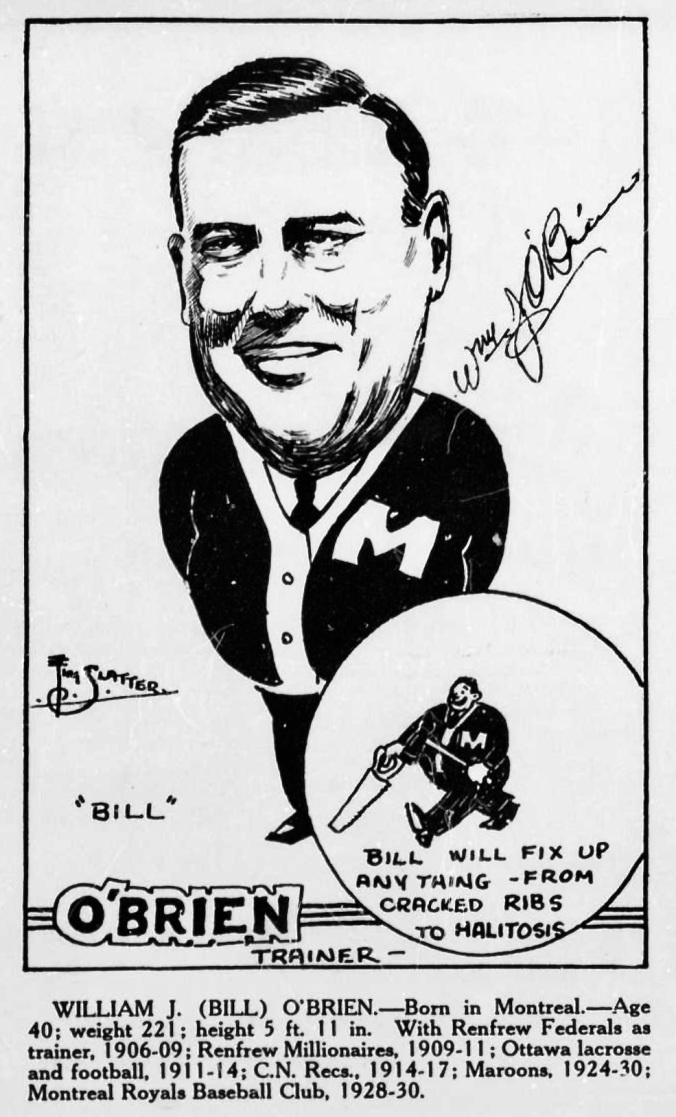Bill O’Brien started his career as a railway baggageman in Montreal with the old Grand Trunk line, but in the early years of the 20th century he took to the sporting life, making a career as a trainer in baseball, lacrosse, football, and hockey that lasted 38 years.
Rinkside, he went in at the top, tending the Renfrew Creamery Kings, the famous Millionaires, of the NHA in 1909-10, when their line-up featured a galaxy of greats, including Lester and Frank Patrick, Cyclone Taylor, and Newsy Lalonde.
Big and genial and expert in the arts of skate-sharpening, sutures, rubdowns, charley-horse mitigation, and the all-round management of hockey players, O’Brien signed on in the 1920s with the Montreal Maroons, making his name with them.
“Bill O’Brien was more than a trainer of hockey teams,” Red Dutton said when the trainer died in 1944 at the age of 57. “He was an institution in the National League, known by everybody, liked and respected by everybody.”
The Gazette’s Dink Carroll weighed in sorrowfully at that time, too. “Something has gone out of sport in this city with the passing of his enormously kindly and competent man.”
“He had all the technical competence of a first-class man at his job. He knew anatomy and something of osteopathy. His hands were those of a natural healer. He understood the lamps and diathermal machines and kept abreast of every new development along those lines.”
He was an early advocate of fitness training for NHLers at a time when they mostly … didn’t do that. To keep the Maroons trim during the summer months in the late ’20s, he conspired with team captain Dunc Munro to see a full range of gym apparatus installed at the Montreal Forum, along with a rowing machine and a badminton court.
He went over to the Canadiens late in his career, and he was revered on their side of the Forum, too.
Away from the ice, O’Brien tended Ottawa’s football Roughriders, too, in his time, as well as baseball’s International League Montreal Royals and, in the early ’40s, the mighty major-league Brooklyn Dodgers.
In 1938, Marc McNeil of the Gazette asked O’Brien and another multi-tasking trainer, Eddie Froelich, to rate the major North American sports by toughness, which is to say, which was the most punishing on players. O’Brien’s ruggedness rating had hockey at the top, followed by basketball, football, and baseball.
Froelich, who was the trainer for the Chicago Black Hawks as well as baseball’s White Sox, the Boston Red Sox, and the New York Yankees at one time and another, put hockey, football, and baseball on a par. Baseballers didn’t see as much contact, of course, but he felt that it was more difficult for them to return from injury because of the movement needed to bat and throw and field. Hockey players, he said, didn’t generally absorb as much punishment as people thought: on skates, his logic went, they moved too fast to absorb the full force of most blows.
Bill O’Brien and his wife Mary had two sons, who turned out to be distinguished hockey chroniclers both. Larry O’Brien was a reporter for the Montreal Standard as well as the Star, and then a broadcaster of Montreal Royals games before ending up as golfer Jack Nicklaus’ publicist. Andy O’Brien started out as selling programs at the Forum when his dad was working for the Maroons, then graduated to serve as the team’s stickboy the year they won their first Stanley Cup, 1926. He worked for the Standard and the Star, too, covering 12 Olympiads, 45 Stanley Cup finals, and 31 Grey Cups in his time. Andy O’Brien also published a respectable shelf’s worth of hockey books, including Firewagon Hockey: The Story of the Montreal Canadiens (1967), The Jacques Plante Story (1972), which he co-authored with the goaltender himself, as Hockey Wingman (1967), a novel.

